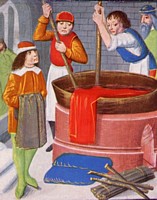Social Workers as “Peace Weavers”
 |
| A peace weaver is always multitasking |
In Anglo Saxon epic poems, such as
Beowulf, they mention women as being “peace weavers”
high-born woman who marries to make peace or keep the peace between powerful dynasties and tribes.
The role of peace weavers were vital and included not only keeping the home but
being protectors of all those who lived there. Some ways they did this were by
graciously hosting events, honoring each visitor with respect and courtesy and
even being given in marriage as a human treaty between two nations. The women
were also tasked with physically and emotionally defending what was theirs,
some women even trained armies and took them to war, as in the case of Aethelflaed.
She has been described as 'our greatest woman-general,one of the most effective leaders we ever had, who commanded troops for eightyears of decisive warfare, and ruled a country as well. In Beowulf, Queen Wealhtheow, in her speech
welcoming Beowulf and his compatriots, spoke of the reinforcement of social unity, and the authority needed to ensure it. Women would intercede in
negotiations and urge men toward reconciliation with speech and
encouragement. These were women of substance, grace, eloquence and would stop
at nothing to protect the human rights of all in their care.
As a social worker we are tasked with the
emotional and physical protection and empowerment of our clients. We are advocates
for peace and will use our words, actions and resources to help our clients
forge the best life possible. We not only focus on the client in front of is
but consider the entire vulnerable populations. We attack big picture issues
like policy changes, protection of human rights and social justice. We care for
people who we barely know but treat them as they are our number one
priority-because they are. We are governed by several documents but the largest
of them is the Universal Declaration of Human Rights. This document covers all
the basic rights people should be afforded, but not always are. In the case of
being peace weavers, social workers strive every day to make lives better by
empowerment, advocacy and the pursuit of equality.
As the peace weavers in Anglo Saxon
literature, social workers are on the front lines trying to improve lives. We fight
for each client we have as well as being politically active to affect change on
a policy level. So the role of women in Anglo-Saxon society, at least according to Beowulf, is far from simple or marginalized; from brokering peace to reminding the men of their vows and pledges, women are the “‘mortar that cements the bricks;’ they facilitate relationships among men. If we
compare policy changes to treaties between warring tribes and the gracious
protection of all members of the household and guests to the dedication and
empowerment of our clients, social workers are the modern day peace weavers.
